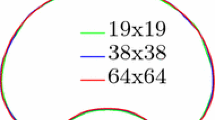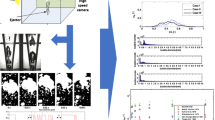Abstract
Many industrial systems make use of two-phase flows for processing or safety applications. Modeling these flows is essential for ensuring safety and engineering optimization. In general, these flows are modeled using the two-fluid model. Two key parameters in the two-fluid model are void fraction and interfacial area concentration. To improve model accuracy, the bubbles are typically broken up into groups based on transport properties and modeled separately. Such models must be validated using experimental data, which is often collected using intrusive probes such as electrical conductivity or optical void probes. Current algorithms for converting the signals from these instruments into void and interfacial area measurements struggled with missing interfaces due to signal rise and fall time. These types of instruments also use the chord length to classify the “group” of a bubble, which can lead to incorrect grouping behavior. In this paper, a new dynamic signal processing method and a grouping algorithm based on calculating bubble diameter have been introduced in an attempt to correct these inaccuracies. The ability of the new algorithm is to correctly identify smaller bubbles and to more accurately identify bubble signals is demonstrated by comparison of the output logic pulse for both the old and new algorithms with the same input signal. The new bubble size calculation means that a number of bubbles that were previously classified as “spherical/distorted” are now classified as “cap/slug/churn” bubbles. This leads to changes in average bubble properties. While these changes were expected in several cases, the increase was larger than the reported uncertainty of the instruments. This may indicate significant shortcomings in data analyzed using the previous algorithms. Additional data collection and analysis is required in order to evaluate this possibility. However, the new algorithm has a significant weakness: the bubble diameter calculation increases the computational t ime by an order of magnitude.
Similar content being viewed by others
Change history
05 February 2022
A Correction to this paper has been published: https://doi.org/10.1007/s42757-022-0132-z
References
Calderbank, P. H., Moo-Young, M. B. 1961. The continuous phase heat and mass-transfer properties of dispersions. Chem Eng Sci, 16: 39–54.
Delhaye, J. M., Achard, J. L. 1976. On the averaging operators introduced in two-phase flows modeling. In: Proceedings of the OECD/NEA Specialists Meeting on Transient Two-Phase Flow.
Fu, X. Y., Ishii, M. 2003. Two-group interfacial area transport in vertical air–water flow: I. Mechanistic model. Nucl Eng Des, 219: 143–168.
Hibiki, T., Ishii, M. 2000. Two-group interfacial area transport equations at bubbly-to-slug flow transition. Nucl Eng Des, 202: 39–76.
Ishii, M., Kim, S. 2001. Micro four-sensor probe measurement of interfacial area transport for bubbly flow in round pipes. Nucl Eng Des, 205: 123–131.
Ishii, M., Kojasoy, G. 1993. Interfacial area transport equation and preliminary considerations on closure relations. Purdue University Report, PU NE-93-6.
Ishii, M., Mishima, K. 1984. Two-fluid model and hydrodynamic constitutive relations. Nucl Eng Des, 82: 107–126.
Ishii, M., Revankar, S. T. 1991. Measurement of interfacial area using four sensor probe in two phase flow. NASA STI/Recon Technical Report N, 91.
Ishii, M., Zuber, N. 1979. Drag coefficient and relative velocity in bubbly, droplet or particulate flows. AIChE J, 25: 843–855.
Ishii, M. 1975. Thermo-Fluid Dynamic Theory of Two-Phase Flow. Paris: Eyrolles.
Kataoka, I., Ishii, M., Serizawa, A. 1984. Local formulation of interfacial area and its measurements in two-phase flow. Argonne National Laboratory Report: NUREG series, ANL-84-68.
Kataoka, I., Ishii, M., Serizawa, A. 1986. Local formulation and measurements of interfacial area concentration in two-phase flow. Int J Multiphase Flow, 12: 505–529.
Kataoka, I., Ishii, M., Serizawa, A. 1994. Sensitivity analysis of bubble size and probe geometry on the measurements of interfacial area concentration in gas–liquid two-phase flow. Nucl Eng Des, 146: 53–70.
Kataoka, I., Serizawa, A. 1990. Interfacial area concentration in bubbly flow. Nucl Eng Des, 120: 163–180.
Kim, S., Fu, X. Y., Wang, X., Ishii, M. 2000. Development of the miniaturized four-sensor conductivity probe and the signal processing scheme. Int J Heat Mass Transfer, 43: 4101–4118.
Kocamustafaogullari, G., Ishii, M. 1995. Foundation of the interfacial area transport equation and its closure relations. Int J Heat Mass Transfer, 38: 481–493.
Neal, L. G., Bankoff, S. G. 1963. A high resolution resistivity probe for determination of local void properties in gas–liquid flow. AIChE J, 9: 490–494.
Paranjape, S. 2016. Bubble diameter calculation. E-mail interview.
Powell, M. J. D. 1970. A Fortran subroutine for solving systems of non-linear algebraic equations. In: Numerical Methods for Nonlinear Algebraic Equations. Gordon and Breach, 87–414.
Rayleigh, L. 1878. On the instability of jets. Proceedings of the London Mathematical Society, s1-10: 4–13.
Shen, X. Z., Mishima, K., Nakamura, H. 2008. A method for measuring local instantaneous interfacial velocity vector in multi-dimensional two-phase flow. Int J Multiphase Flow, 34: 502–509.
Shen, X. Z., Nakamura, H. 2013. Local interfacial velocity measurement method using a four-sensor probe. Int J Heat Mass Transfer, 67: 843–852.
Shen, X. Z., Nakamura, H. 2014. Spherical-bubble-based four-sensor probe signal processing algorithm for two-phase flow measurement. Int J Multiphase Flow, 60: 11–29.
Shen, X. Z., Saito, Y., Mishima, K., Nakamura, H. 2005. Methodological improvement of an intrusive four-sensor probe for the multidimensional two-phase flow measurement. Int J Multiphase Flow, 31: 593–617.
Talley, J. D., Worosz, T., Kim, S. 2015. Characterization of horizontal air–water two-phase flow in a round pipe part II: Measurement of local two-phase parameters in bubbly flow. Int J Multiphase Flow, 76: 223–236.
Author information
Authors and Affiliations
Corresponding author
Rights and permissions
About this article
Cite this article
Mills, C.S.L., Schlegel, J.P. Interfacial area measurement with new algorithm for grouping bubbles by diameter. Exp. Comput. Multiph. Flow 1, 61–72 (2019). https://doi.org/10.1007/s42757-019-0012-3
Received:
Revised:
Accepted:
Published:
Issue Date:
DOI: https://doi.org/10.1007/s42757-019-0012-3




